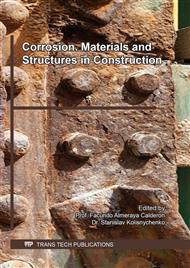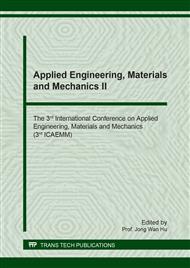[1]
AASHTO (2011). T336-11. Coefficient of Thermal Expansion of Hydraulic Cement Concrete. United States of America, American Association of State Highway and Transportation Officials.
Google Scholar
[2]
M. Ahmed, M. Javed, and H. Mohd Abul. A Study of Factors Affecting The Flexural Tensile Strength Of Concrete,. J. King Saud University – Eng. Sci. (2014).
DOI: 10.1016/j.jksues.2014.04.001
Google Scholar
[3]
J. W. Hu, Response of Seismically Isolated Steel Frame Buildings with Sustainable Lead-Rubber Bearing (LRB) Isolator Devices Subjected to Near-Fault (NF) Ground Motions. Sustain. 7 (2015) 111-137.
DOI: 10.3390/su7010111
Google Scholar
[4]
J. W. Seo, Y. C. Kim, J. W. Hu, Pilot Study for Investigating the Cyclic Behavior of Slit Damper Systems with Recentering Shape Memory Alloy (SMA) Bending Bars Used for Seismic Restrainers, Appl. Sci. 5(3) (2015) 187-208.
DOI: 10.3390/app5030187
Google Scholar
[5]
ASTM (2010). E289-04 (2010). Linear Thermal Expansion of Rigid Solids with Interferometry. United States of America, American Society for Testing and Materials.
Google Scholar
[6]
A. Al-Ostaz, Effect of moisture content on the coefficient of thermal expansion of concrete. No. FHWA/MS-DOT-RD-07-187. Department of Civil Engineering, University of Mississippi, (2007).
Google Scholar
[7]
P. Bamforth. Early-age Thermal Crack Control In Concrete. CIRIA C660. London, CIRIA, (2007).
Google Scholar
[8]
P. Bamforth, D. Chisholm, J. Gibbs and T. Harrison. Properties of Concrete for use in Eurocode 2. UK, The Concrete Society, (2008).
Google Scholar
[9]
N. Buch, and J. Shervin. Quantifying Coefficient Of Thermal Expansion Values Of Typical Hydraulic Cement Concrete Paving Mixtures. Michigan State University, Department of Civil and Environmental Engineering, (2008).
Google Scholar
[10]
G. Crawford, J. Gudimettla, and J. Tanesi, Interlaboratory Study on Measuring Coefficient of Thermal Expansion of Concrete. In: Transportation Research Record: Journal of the Transportation Research Board, No. 2164, Transportation Research Board of National Academies, Washington, D.C., (2010).
DOI: 10.3141/2164-08
Google Scholar
[11]
Danish Technological Institute (1994). TI-B 101 (94). Test Method Expansion Coefficient of Concrete.
Google Scholar
[12]
J. H. Emanuel, and J. L. Hulsey. Prediction of the thermal coefficient of expansion of concrete. J. Am. Concr. Inst.74(4) (1977) 149-155.
Google Scholar
[13]
J. Wang, H. G. Ji, J. J. Wang, et al. Residual life prediction of reinforced concrete elements based on time-varying reliability. Adv. Mater. Res. 163-167(4) (2011) 3258-3262.
DOI: 10.4028/www.scientific.net/amr.163-167.3258
Google Scholar
[14]
Y. F. Fan, S. Y. Zhang, K. Shiho, P. S. Surendra. Influence of kaolinite clay on the chloride diffusion property of cement-based. Cem. Concr. Comp. (45) (2014) 117-124.
DOI: 10.1016/j.cemconcomp.2013.09.021
Google Scholar
[15]
Y. F. Fan, S. Y. Zhang, Q. Wang, P. S. Surendra. Effects of nano-kaolinite clay on freeze-thaw resistance behavior of concrete. Cem. Concr. Comp. (62) (2015) 1-12.
DOI: 10.1016/j.cemconcomp.2015.05.001
Google Scholar
[16]
M. Mathias, D. B. Nele. Resistance of concrete and mortar against combined attack of chloride and sodium sulphate. Cem. Concr. Comp. (53) (2014) 59-72.
DOI: 10.1016/j.cemconcomp.2014.06.013
Google Scholar
[17]
J. H. Liu, L. Zhao, H. G. Ji. Influence of initial damage on degradation and deterioration of concrete under sulfate attack. Chinese J. Eng. 39(8) (2017) 1278-1287.
Google Scholar
[18]
G. J. Al-Sulaimaini, et al. Influence of corrosion and cracking on bond behavior and strength of reinforced concrete members. ACI Struct. J. 87(2) (1990) 220-231.
DOI: 10.14359/2732
Google Scholar
[19]
T. Shuenn-Chern, et al. Effect of reinforcing steel area loss on flexural behavior of reinforced concrete beams. ACI Struct. J. 88(3) (1991) 309-314.
DOI: 10.14359/2709
Google Scholar
[20]
W. W. George and F. W. Kurt. Fifty years properties of concrete. ACI J. (1975) 20-28.
Google Scholar
[21]
F. Puertas, S. Martinez-Ramirez, S. Alonso, T. Vazquez. Alkali Activated Fly Ash/Slag Cement.Strength behaviour and hydration products, Cem. Concr. Res. 12(8) (2000) 1625-1632.
Google Scholar
[22]
N. Q. Feng, F. Xing. Durability of concrete and concrete structure. Beijing, China machine press, (2013).
Google Scholar



